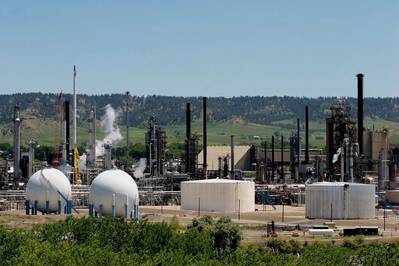Oil Prices Climb on Hopes of Deeper OPEC+ Production Cuts
Oil prices edged higher on Thursday as investors focused on the possibility of deeper supply cuts from the world's biggest producers, whilst largely shrugging off reports which cut demand forecasts after the coronavirus outbreak in China, the biggest oil importer.
Brent crude was up 32 cents, or 0.6%, at $56.11 a barrel by 10:52 a.m. ET (1552 GMT), while U.S. West Texas Intermediate (WTI) was up 14 cents at $51.31 a barrel.
The energy complex was led higher by U.S. gasoline futures , which jumped more than 1%, supported by outages at Exxon Mobil Corp's 502,500 barrel-per-day (bpd) Baton Rouge, Louisiana, refinery after a fire and Phillips 66's 285,000-bpd Bayway refinery in Linden, New Jersey.
The Organization of the Petroleum Exporting Countries lowered its 2020 demand forecast for its crude by 200,000 bpd, prompting expectations the producer group and its allies, known as OPEC+, could agree further output cuts when they next meet, possibly as early as this month.
"The Russians have pretty much signaled that everyone is on board for OPEC+ delivering deeper production cuts," said Edward Moya, senior market analyst at OANDA in New York.
"Crude's price action possibly suggests a firm bottom is in place. As long as the coronavirus does not show strong signs that the spreading of the virus is intensifying, WTI crude could make a run towards the mid-$50s."
Oil demand in China, the world's second-largest crude consumer, has plunged because of travel restrictions to and from the country and quarantines within it.
Hubei province, the epicentre of the outbreak, said on Thursday the number of new confirmed cases there jumped by 14,840 to 48,206 on Feb. 12 and that deaths climbed by a daily record of 242 to 1,310, reflecting changes to the diagnostic methodology.
Oil refiner China National Chemical Corp said on Thursday it would close a 100,000 bpd plant and cut processing at two others amid falling fuel demand.
The International Energy Agency (IEA) expects oil demand in the first quarter to fall for the first time in 10 years before picking up from the second quarter. The agency cut its full-year global growth forecast to 825,000 bpd.
"(It's) worth noting that these forecasters are for now assuming a V-shape recovery in oil demand, with the bulk of the impairment concentrated in Q1, 2020," BNP Paribas analyst Harry Tchilinguirian told the Reuters Global Oil Forum.
Brent and WTI have fallen more than 20% from their January peak because of the disease outbreak.
"All of the fundamentals are basically negative and even equities are lower and crude oil on the other hand continues to rip higher," said Bob Yawger, director of futures at Mizuho in New York.
"You can argue that maybe those demand numbers aren't as bad as the market thought they could be."
Lower fuel demand expectations because of the virus have also shifted the market structure for both Brent and WTI into a contango - where prompt prices are lower than those for later dates.
The six-months spread of Brent futures contracts <LCOc1-LCoc7> is at about minus 40 cents.
(By Devika Krishna Kumar, Additional reporting by Laila Kearney in New York, Shadia Nasralla in London, Jane Chung in SEOUL; Editing by Marguerita Choy and Mark Potter)













